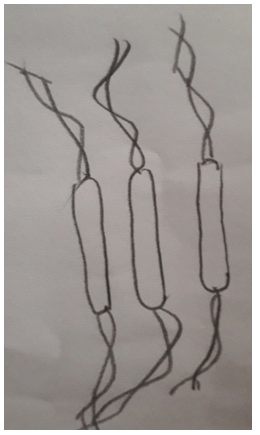This set of Class 11 Biology Chapter 2 Multiple Choice Questions & Answers (MCQs) focuses on “Biological Classification – Monera”.
1. Monera comprises of prokaryotic organisms like bacteria which are the oldest life forms of the earth. Bacteria are classified based on their shape.
a) True
b) False
View Answer
Explanation: All the prokaryotic organisms are grouped under Monera. Bacteria are classified based on their shape as Coccus, Bacillus, Vibrium and Spirillum.
2. The bacteria shown in the following picture belongs to the category________

a) Coccus
b) Bacillus
c) Vibrium
d) Spirillum
View Answer
Explanation: Coccus refers to the spherical shaped bacteria, Bacillus refers to the rod shaped bacteria, Vibrium refers to the comma-shaped bacteria and Spirilla refer to the spiral shaped bacteria.
4. Dunaliella salina belongs to the category of ________
a) Halophiles
b) Thermophiles
c) Hydrophiles
d) Methanogens
View Answer
Explanation: Dunaliella salina belongs to the category of Halophiles. Halophiles can survive in areas which are highly concentrated in salt. Thermophiles can survive in conditions with high temperature. Methanogens are responsible for production of methane.
5. Methanogens are present in the ______
a) Mouth of cow
b) Guts of cow
c) Respiratory system of cow
d) Ribs of a cow
View Answer
Explanation: Methanogens are responsible for production of methane. These are present in marshy areas like guts of a cow which helps in production of biogas from cow dung.
6. Archaebacteria can survive in extreme conditions because of the ________
a) complex metabolic reactions in their body
b) fact that they are the oldest life forms on the earth
c) rigid cell wall they have
d) double membrane nucleus
View Answer
Explanation: Archaebacteria have a rigid cell wall which helps them to survive in extreme conditions like high salt concentration (halophiles) and very high temperature (thermophiles).
7. In chemosynthetic autotrophs energy to prepare food is obtained from __________
a) Light energy
b) Chemical energy
c) Bio-energy
d) Thermal energy
View Answer
Explanation: Bacteria adopt different modes of nutrition like photosynthetic, chemosynthetic, saprophytic and parasitic. Chemosynthetic autotrophs prepare their own food by obtaining energy from organic substances.
8. Which among the following is incorrect about Cyanobacteria?
a) The word cyano means greenish-blue because of which cyanobacteria is also called as blue-green algae
b) The colour of cyanobacteria is due to presence of chlorophyll
c) Cyanobacteria are chemosynthetic autotrophs
d) Cyanobacteria help in enriching oxygen levels in the atmosphere
View Answer
Explanation: Cyanobacteria contain chlorophyll which helps to perform photosynthesis and in turn enrich the oxygen levels in the atmosphere. The word “cyano” in cyanobacteria means blue-green algae and therefore they are also called as blue-green algae.
9. Pseudomonas adopt ___________
a) Parasitic mode of nutrition
b) Heterotrophic mode of nutrition
c) Saprophytic mode of nutrition
d) Autotrophic mode of nutrition
View Answer
Explanation: Parasites obtain food from the host. Heterotrophs obtain food from autotrophs. Saprophytes feed on dead and decay matter. Autotrophs prepare their own food either by using light energy or chemical energy. Pseudomonades are Heterotrophs.
10. Which among the following are incorrect about Mycoplasma?
a) It has rigid cell wall
b) It adopts parasitic mode of nutrition
c) It is present in urogenital tract and in rare cases, in blood smears
d) Mycoplasma is extremely small in size
View Answer
Explanation: Mycoplasma has no cell wall. It is parasite and is present in urogenital tract and in rare cases, in blood smears. Mycoplasma is extremely small, ranging from 0.2 to 0.3 micrometers in size.
11. E.Coli is a rod-shaped bacterium present in ________
a) Digestive tract of humans
b) Respiratory tract of humans
c) Urogenital tract of humans
d) Excretory tract of humans
View Answer
Explanation: Escherichia coli is a rod-shaped bacterium present in the digestive tract of warm-blooded animals like human beings and is responsible for the indigestion problems in humans.
12. Which among the following is incorrect about Lacto bacilli?
a) These are rod shaped bacteria
b) These are the bacteria responsible for turning milk into curd
c) These are parasites
d) They are also useful in industries for fermentation of wine
View Answer
Explanation: Lacto bacilli, as the name says, are rod shaped bacteria that are responsible for turning milk into curd. They adopt heterotrophic mode of nutrition. These are also useful in fermentation of wine.
13. Bacteria reproduce by ___________
a) Sexual reproduction
b) Asexual reproduction
c) Spores
d) Sexual reproduction and asexual reproduction
View Answer
Explanation: Bacteria reproduce either by asexual reproduction or sometimes adopt sexual mode of reproduction. In sexual reproduction they mainly adopt conjugation in which DNA transfer takes place from one bacterium to other. In asexual reproduction they undergo binary fission.
14. Assume that the growth of bacteria follows first order kinetics with a rate constant of 2/s. If the initial population of the bacteria is 2000, then the population of it after 30s will be _____
a) 2 × 1029
b) 4 × 1029
c) 2 × 1030
d) 8 × 1029
View Answer
Explanation: n = N×ekt = N×10kt/2.303
Where, n = current population
N = initial population
k = rate constant
t = time taken
n = 2000×102×30/2.303 = 2×1029.
Sanfoundry Global Education & Learning Series – Biology – Class 11.
To practice all chapters and topics of class 11 Biology, here is complete set of 1000+ Multiple Choice Questions and Answers.
If you find a mistake in question / option / answer, kindly take a screenshot and email to [email protected]
- Check Class 11 - Books
- Practice Class 11 - Physics MCQs
- Practice Class 12 - Biology MCQs
- Practice Class 11 - Chemistry MCQs
- Practice Class 11 - Mathematics MCQs
